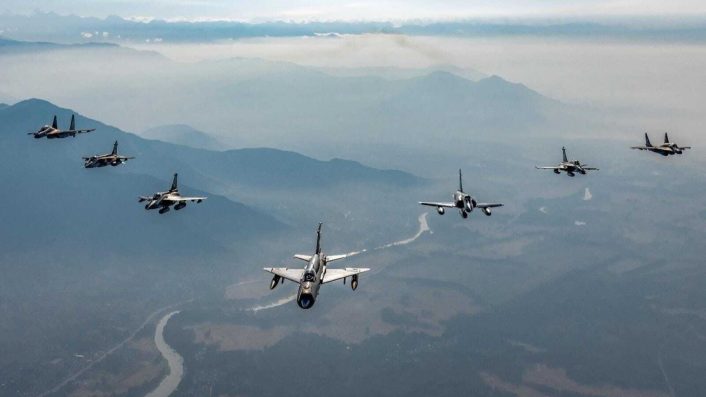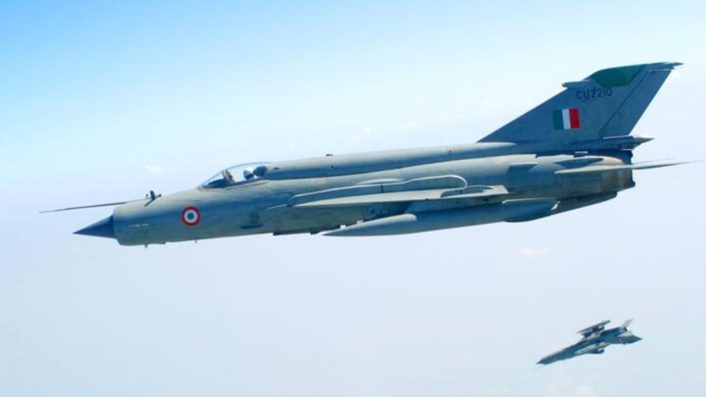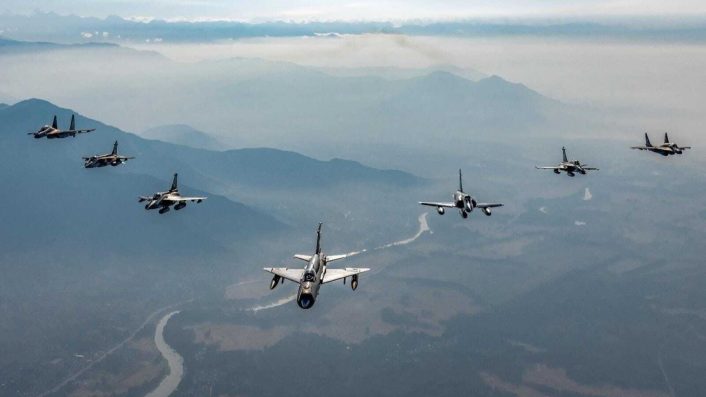Today the IAF phased out the MiG-21 Bison after a 62-year-long career, spanning two thirds of the air force’s total lifespan.
The MiG-21 is often thought of as synonymous with the Indian Air Force, being the largest user of the aircraft outside of the Soviet Union itself, with Hindustan Aeronautics Limited (HAL) domestically producing around 600 fighters of the 872 aircraft that were inducted into the IAF between 1966 and 1980. It was the IAF’s first supersonic jet fighter and by far the longest serving in the service, being the backbone of the fleet from its induction in 1963 until its retirement this year.
This day had been delayed several times with the MiG-21 originally supposed to retire in the 1990s, but it was kept on the IAF’s books in order to keep their squadron numbers at an acceptable level, whilst delays with its replacement were sorted. Eventually India produced its first domestic supersonic fighter, the HAL Tejas light fighter, with its prototype flying in 2003. Additional delays with full-rate production meant that the Tejas didn’t officially enter service until 2015, with it not ready to replace the MiG-21 until the 2020s.
The delayed HAL (Hindustan Aeronautics Limited) LCA Tejas Mk-1A also found a fresh order on Sep. 25 for 97 jets in Rs. 60,000 crore ($6.7 billion) deal, on top of the 83 that the IAF had already ordered in February 2021. This should ease the pressure on the IAF – eager to meet its combat air patrol and point defense needs. General Electric also resumed the supply of the GE F404-IN20 engines, the delay of which HAL said held back Tejas Mk-1A deliveries.

However, these bumps in the road for the new fighter seems to have been pushed through as the Indian government has just signed the contract for a further order of 97 Tejas MK 1A totaling $7 billion USD. This means that whilst the loss of the two MiG-21 squadrons will see the total fighter squadron numbers dip to 29 instead of the officially mandated 42, the order of further Tejas brings hope that this dip will not be for a long period of time.
The Indian government and the IAF view that 42 fighter squadrons are necessary for combating both the Pakistani Air Force and the People’s Liberation Army Air Force, at the same time. Indeed, the significant bulk of the IAF is strategically placed against these two powers, with this forming the central focus of Indian defense planning. Each squadron is meant to operate 18 aircraft.
Given the age of the type and more specifically the age of its airframes, the retirement of the MiG-21 at this juncture is likely to bring more good than harm to the overall structure of the IAF. Only two squadrons of MiG-21 are left in service, split between No. 23 Squadron IAF ‘the Panthers’ and No. 3 Squadron ‘the Cobras’, both of which will convert onto the Tejas Mk 1A as more are introduced into IAF service.
— Ministry of Defence, Government of India (@SpokespersonMoD) September 26, 2025
The decommissioning ceremony took place today, Sept. 26, 2025, at Chandigarh AFS (Air Force Station), the same airbase where the first six MiG-21 aircraft were delivered to the IAF. Those original aircraft joined No. 28 Squadron, which became known as ‘The First Supersonics’ as a result of their acceptance of the aircraft. The squadron currently operates the MiG-29, themselves having flown this aircraft for almost forty years.
The ceremony saw a special flypast commemorating the MiG-21 and its long history with the current Chief of the Air Staff, Air Chief Marshal Amar Preet Sign. He led a formation of six aircraft, including one flown by Squadron Leader Priya Sharma, the seventh woman to fly in the IAF and now the last woman to fly the MiG-21. After landing, the formation was met with a water cannon salute, signaling the end of the era that was the IAF’s first and longest-lived supersonic jet fighter. This formation was followed by the IAF’s Surya Kiran display team flying the BAE Systems Hawk MK 132 jet trainer.
Controversial Flight Safety
The MiG-21’s retirement follows the aircraft having fallen into disrepute due to the aircraft’s high crash rate in IAF service. This has drawn the ire of many towards the IAF for not retiring the MiG-21 sooner and replacing it with a safer aircraft. Of the 872 airframes that were inducted since 1963, around 400 have been lost to accidents beginning from 1971-72, killing over 200 pilots and 50 civilians.
#MiG21 culmination ceremony
26 Sep 2025#MiG21#indianairforce@DefenceMinIndia@SpokespersonMoD@HQ_IDS_India@adgpi@indiannavy@IndiannavyMedia@CareerinIAF pic.twitter.com/CL0lKVjDKI— Indian Air Force (@IAF_MCC) September 25, 2025
As a result, it earned the sobriquets of “Flying Coffin” and the “Widow maker,” generating an image of an IAF that was apathetic to aircraft safety, and the lives of its pilots. The main reason is more to do with India’s famously slow defense procurement process, being unusually vulnerable to bureaucratic and political exigencies than possibly any other country.
The last MiG-21 crash took place on May 8, 2023, when a MiG-21 Bison (MiG-21bis) from the same No. 23 Squadron crashed in the Western Indian state of Rajasthan, killing three civilians. Prior to that, on Jul. 28, 2022, a MiG-21 UM from the No. 4 Sqn crash killed Wing Commander M. Rana (38) and Flight Lieutenant Advitiya Bal (26).
IAF officers meanwhile counter consistent criticisms of the service not phasing out the old jet, since new acquisitions such as the aforementioned Tejas MK 1A remain stuck. The IAF’s acquisition of the French Rafale also remains slow, due to the slow rate of production of the Dassault aircraft in France.
Goodbye, you beauty.
(Photo by my friend @TheFlyingJunkie) pic.twitter.com/QXIM1mkx4M
— Angad Singh (@zone5aviation) September 26, 2025
The IAF distinguishes between ‘obsolescence’ and the ‘flyability’ of an aircraft where only aircraft deemed to be unflyable are divested immediately. The serviceable ones are those assessed to have parts that can be still repaired or replaced. Even the serviceable aircraft are retired for other miscellaneous reasons.
Two other reasons are unpredictable material failures, and the rare pilot or maintenance error, none of which are known under the IAF’s Boards of Inquiry, almost always outside public scrutiny. The ones least avoidable are equipment snags, that can happen despite parts undergoing thousands of hours of ‘non-destructive testing’ by the developer, in this case the Mikoyan Design Bureau.
IAF pilots blame the high crash rate of the MiG-21 on the long service life of the platform, being the longest serving and largest fleet of jets in the IAF. Pilots nevertheless love the jet and swear by its reliability as a fighter-interceptor and ground attack jet, which requires “unforgiving respect and impeccable skill,” according to an unnamed retired Air Vice Marshal rank officer.
#MiG21 Daily Pic: D minus 4
Dusk at Bikaner (Nal). A Type-96 from 108 Sqn knifes off the runway, afterburner painting the desert gold—while a 14 Sqn Jaguar flight watches, a little awestruck.
📷 Sanjay Simha
#MiG21India #IAFHistory https://t.co/JMmcbcVNpF pic.twitter.com/vSbFCoTbyx
— Anchit Gupta (@AnchitGupta9) September 22, 2025
He also claims, albeit carefully, that “in certain ideal” tactical, teaming and terrain situations, and if handled by a seasoned pilot, the MiG-21bis can even best a Gen. 4 and Gen. 4.5 fighter, exploiting its low RCS (Radar Cross Section), speed and BVR (Beyond Visual Range) missile capability.
Unusual Flight Characteristics
The MiG-21 has unfamiliar flight characteristics to many of the other aircraft types flown by IAF pilots. This is especially true for pilots from the 1970s who transitioned from subsonic aircraft such as the Dassault Mystere and the Hawker Hunter. These flight characteristics are caused by the nose intake, delta-wing and the whopping landing speed of 360 km/hour.
The initial batch of pilots were unaccustomed to induced drag at lower speed and the slow engine response that resulted from it. Foreign Object Damage (FOD) and bird strikes due to rapid urbanization around air bases were other reported causes for the high crash rate early on during the aircraft’s lifespan.
Additionally, the thin delta-wing could result in a ‘super-stall’ where the aircraft sinks at a rapid rate of 100-150 meters per second, losing about 20-30,000 feet within a minute. Unfortunately, this was often fatal and led to such a high number of losses.

This wing also allowed the MiG-21 to glide for a fair distance with the engine out, often contributing to engine failures going unnoticed. Back then the IAF also lacked an Advanced Jet Trainer (AJT) for their Stage-III flight training, after having flown the HJT Kiran and the PZL TS-11 Iskra in Stage II.
As the MiG Operational Flying Training (MOFT) was directly being done on the MiG-21, a trainee went from an aircraft with a speed of 240 kms an hour, to one with a landing speed of 366 km. It was only in Nov. 2007 that the British BAE Hawk meant for the Stage-III Advanced Jet Training began arriving in India.
Relevance and Future
This nevertheless does not diminish the MiG-21’s contribution to the IAF’s history. The MiG-21 has seen action during the 1971 Bangladesh Liberation War, the 1999 Kargil Conflict and the Feb. 27, 2019, air clash over Kashmir between the Indian and Pakistani air forces. While the IAF did lose a MiG-21bis in the skirmish to a U.S.-made AIM-120 AMRAAM, the pilot Wg. Cdr. Abhinandan Varthaman ejected and landed in Pakistani hands, before being handed back.
#MiG21 Daily Pic: D minus 1
Knife-bright against a continent of white. She threads the cornice, her engine song swallowed by snow. One last dawn before the mountain sentry hands in her keys.
📷 Gp Capt Puneet Narain
#MiG21India #IAFHistory https://t.co/OfALsh9ijr pic.twitter.com/TEPmnbmuQ6
— Anchit Gupta (@AnchitGupta9) September 25, 2025
This last incident, highly publicized in India, saw claims that said the MiG-21bis shot down a Pakistani F-16 Fighting Falcon. However, this has been widely disputed by both the Pakistani and American governments. The IAF on its part had shown the disappearance of a blip from a screen of a tactical control center, explaining the vanishing of the blip of the radar picture meant the PAF F-16 was lost.
In Kargil MiG-21s were used in the ground attack role, strafing Pakistani ground positions with unguided rockets on the Himalayan ranges. This gave the MiG-21 an iconic look, flying with two underwing two B8M1 rocket pods containing 20 S-8 rockets each.
The IAF recorded its last confirmed kill on Aug. 10, 1999, when a MiG-21 shot down a Pakistan Navy Breguet Atlantique which had reportedly violated Indian airspace in the Rann of Kutch in western India’s Gujarat. The MiG-21bis was the most advanced type in the IAF inventory, delivered between 2000 and 2005. Upgraded with Israeli help, the jet had a new powerful Russian Kopyo radar for BVR missiles, an Israeli Elbit EL/L8222 jamming pod and a new Inertial Navigation System (INS), making it a fairly advanced Gen. 3 jet.
IAF Mig-21 in air combat has shot down:
1 F-86
2 F-6
4 F-104
1 C-130
1 Atlantique and
1 F-16📷: @VelocityTTL pic.twitter.com/8hM2NQaS0N
— Sankalan Chattopadhyay (@VinodDX9) September 25, 2025
With the retirement of the MiG-21 the IAF looks to the future, dominated by 4.5 and 5th Generation fighters. There is constant speculation over Indian procurement of both the Russian Su-57 and the American F-35, although so far a signed order of either is far from certain. As both Pakistan and China rapidly modernize their air forces, the pressure on the IAF is set to increase in the near future.


